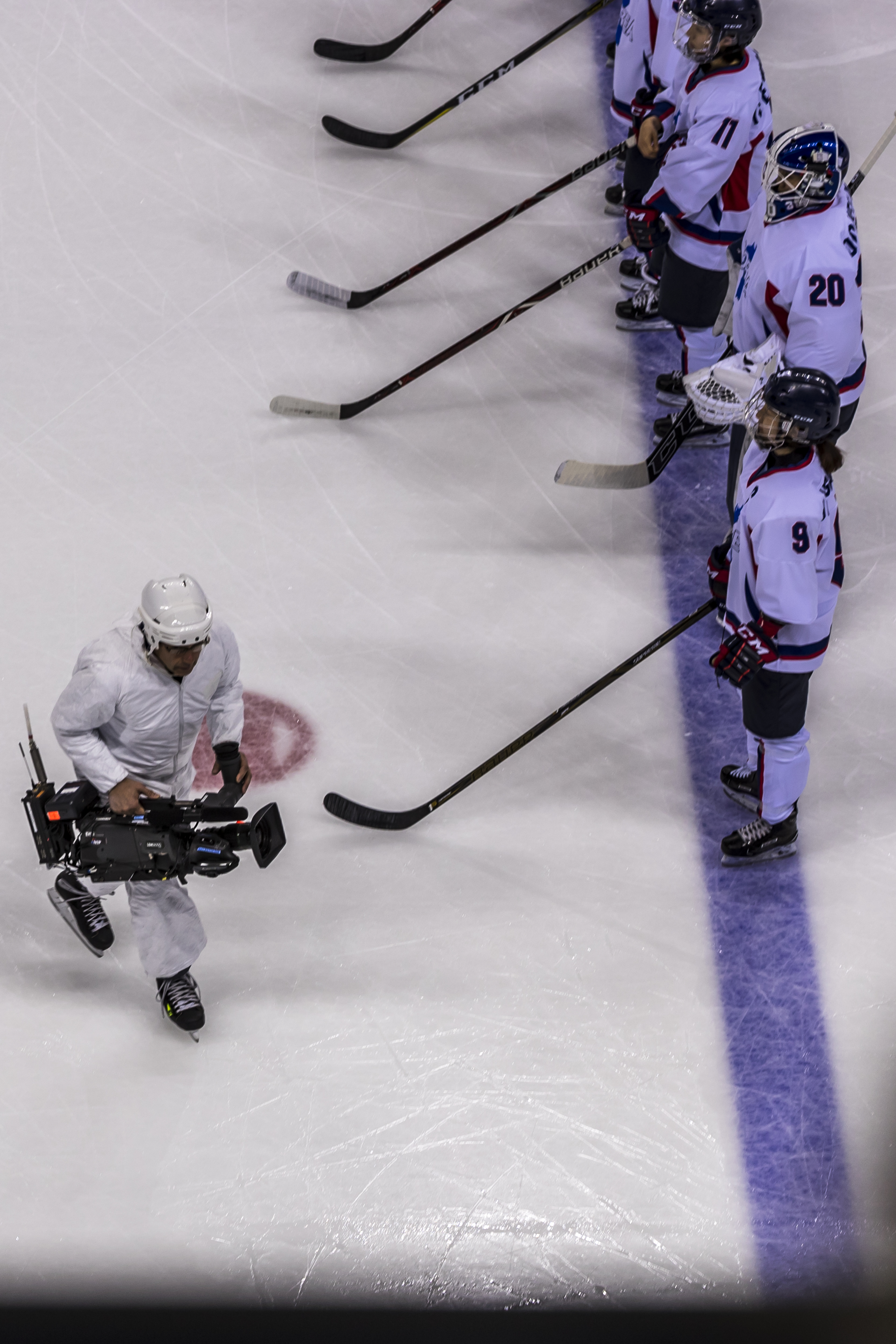The TV Technology Behind the Beijing Winter Olympics
UHD, Immersive Audio and 5G highlight tech advances for Olympic Broadcast Services

BEIJING—When the 2022 Winter Olympics Games get underway in Beijing next month (Feb. 4-20), many of the challenges that broadcasters faced when covering the Summer Olympics in Tokyo will remain as Covid continues to impact everyday life. However, there are a number of lessons learned that the Olympic Broadcasting Services will put into place to ensure a safe and smooth-running two-week event.

When the 2020 Summer Olympics in Tokyo were postponed from 2020 to the summer of 2021, broadcasters no longer had the luxury of having a year and a half between the Winter and Summer Games. With the 2022 Games coming only six months after the Tokyo gathering, this created a whole new set of challenges for OBS.
“The pandemic created a very, very complex situation, where the two games came very close to each other,” said Sotiris Salamouris, CTO for Olympic Broadcasting Services. “This was totally unexpected and I wouldn’t say was easy to deal with.”
When the Tokyo Games were postponed in March 2020, the International Broadcast Centre (IBC) in Tokyo, home to the thousands of broadcasters covering the Games, was within several weeks of becoming operational. With the event postponed, the OBS had to put a freeze on their plans, send their personnel back home and organize a plan to maintain operations until the actual Games took place.
As if handling such logistics in the middle of a pandemic with the related safety precautions and travel restrictions were not enough, the postponement also forced OBS to focus on planning, building and maintaining two operational centres at once.
The Summer Games, however, were held and were a success, Salamouris said. “Tokyo proved that you can still have a very successful major event like the Olympics, even in such conditions, and we are confident that that will continue in Beijing.”

The Importance of the Cloud and IP
The key to providing the most comprehensive source of live programming to the world’s broadcasters when covering the Games is IP and the cloud, which characterizes much of the way media companies have managed to maintain live TV coverage worldwide to meet the challenges of the past two years.
Get the TV Tech Newsletter
The professional video industry's #1 source for news, trends and product and tech information. Sign up below.
Salamouris says using IP tools and the cloud played an important role in planning and designing the IBC and its production workflows.
Salamouris calls the cloud “an essential facilitator because it allows us to build a virtual infrastructure to be established long before we even go to the facility. We don’t have any limitations. It can be pre-tested months or even years before you really reach the facility together with your partners. Then you just spin it down and you spin it up again as needed.”
For the Tokyo games as well as Beijing, OBS has teamed up with Alibaba Group to create OBS Cloud, a suite of custom-made cloud-based solutions specifically adapted to the extremely demanding, data-heavy broadcast workflows. OBS says its cloud service offers the high-performance connectivity, processing and storage capabilities required for the broadcast of the Games. Not only can rights-holding broadcasters access all OBS content remotely, but they are also now able to set up their own content creation, management and distribution systems within the platform.

UHD, Immersive Audio & 5G
The Tokyo Summer Games represented the first Olympics that the OBS provided UHD/HDR coverage and the 2022 Winter Games will mark the first such 4K UHD/HDR coverage of the winter event. Although various broadcasters have recently dabbled in UHD coverage of the Games, OBS developed an infrastructure that allows them to synchronize content whether it’s in 1080i HD or 4K UHD, making it easier for rights-holding broadcasters to manage and access ultra high-resolution content.
This setup was deployed in Tokyo and is quite unique, according to Salamouris. “We have one unified production unit,” he said. “All of our coverage is exactly the same in HD and UHD.”
For audio, OBS expanded its options to go beyond 5.1 channel audio that had been the norm up until Tokyo. For Beijing, OBS will provide immersive audio.
“It’s an emerging standard that gives you an additional high level of audio that allows broadcasters to use it because it’s discreet and not compressed so it can meet the distribution standard according to their needs,” Salamouris said. And with a unified HD/UHD production infrastructure, “whether broadcasters pick up HD or UHD they will always be able to receive immersive audio.”
Another innovation that will form an important part of OBS’s coverage is the increasing use of 5G wireless.
The use of 5G “is even more important because in the Games we have a serious problem with the lack of frequencies, because we need a large number of RF crews just to do our coverage,” Salamouris said. “And 5G helps because you can rely on an established network to do our wireless transmissions instead of relying on dedicated technology that we don’t have enough of anymore.”
Facilities and Gear
Since the Winter Games have always been smaller than the summer version, the Beijing IBC will likewise be smaller than Tokyo’s. And as has been the case for the past several decades, Panasonic will serve as the official provider of a large part of the broadcast production gear to cover the Games.

“They are supporting us with many systems, not just cameras, and indeed they’re providing us the biggest part of our camera systems that we’re using because we have a large number of ENG teams that go around to different venues and even in the city where they’re shooting stories, all of these cameras are Panasonic,” Salamouris said.
Since the Summer Games were held in Beijing in 2008, the city already had an IBC building, however for the Winter Games, a new 419,000+ square-foot facility was built, with more than 220,000 square feet dedicated to broadcast studios and production. A smaller 129,000+ square-foot broadcast centre is strategically located in the mountains.
With more than 6,000+ hours of content expected to be produced, and an increasing portion of it being delivered to non-traditional broadcast providers, the focus on producing content for the variety of digital platforms has taken on added importance, according to Salamouris.
“Our support [for the right-holding broadcasters] needs to be on two fronts: First of all, to give them more content because they have more distribution channels,” Salamouris said, “And number two is to give them technology that makes this easier for them. So a lot of our common delivery now is happening in a digital-friendly manner. IP delivery is very important for the broadcasters to be able to easily to convert the content that we’re giving to them to formats that are used by the devices that they are putting online.”
China, and the city of Beijing in particular, has experienced a rapid technological transformation, especially since the Games were last held in the city in 2008, which Salamouris was also a part of and he marvels at the ubiquity of digital technology, in particular the popularity of mobile devices. He also notes that this element offers advantages in finding a large number of local technology companies and experts to support its production.
“I think the Chinese population, especially here in Beijing that I see, is probably the most digital-ready population anywhere in the world,” he said. “They really use mobile phones for everything, including transactions, collaboration for communication, for really everything. It helps a lot when you're interfacing with people in terms of planning, in terms of finding all the skills that we need from local personnel to be able to work with. You are in an environment where technology is not a stranger.”
Tom has covered the broadcast technology market for the past 25 years, including three years handling member communications for the National Association of Broadcasters followed by a year as editor of Video Technology News and DTV Business executive newsletters for Phillips Publishing. In 1999 he launched digitalbroadcasting.com for internet B2B portal Verticalnet. He is also a charter member of the CTA's Academy of Digital TV Pioneers. Since 2001, he has been editor-in-chief of TV Tech (www.tvtech.com), the leading source of news and information on broadcast and related media technology and is a frequent contributor and moderator to the brand’s Tech Leadership events.

